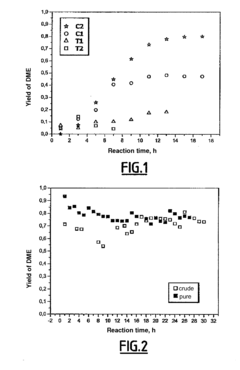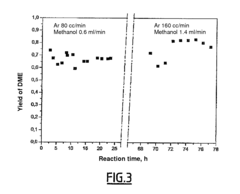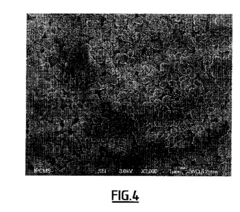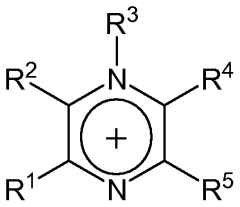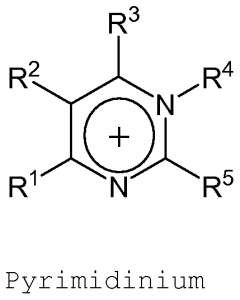Dimethyl Ether: Engineering Breakthroughs in Energy Instruments
JUL 1, 20259 MIN READ
Generate Your Research Report Instantly with AI Agent
Patsnap Eureka helps you evaluate technical feasibility & market potential.
DME Technology Evolution
The evolution of Dimethyl Ether (DME) technology in energy instruments has been marked by significant engineering breakthroughs over the past few decades. Initially developed as a propellant and refrigerant, DME has emerged as a promising alternative fuel due to its clean-burning properties and versatile production methods.
In the 1990s, researchers began exploring DME's potential as a diesel fuel substitute. This period saw the development of early DME production techniques, primarily through the dehydration of methanol. The focus was on small-scale production and laboratory testing to understand DME's combustion characteristics and emissions profile.
The early 2000s witnessed a shift towards larger-scale DME production. Engineers developed more efficient catalysts for the methanol-to-DME process, improving yield and reducing energy consumption. Simultaneously, direct synthesis methods from syngas gained traction, offering a more cost-effective production route for large-scale operations.
By the mid-2000s, the first commercial DME plants were established, primarily in Asia. These facilities demonstrated the feasibility of industrial-scale DME production, paving the way for its use in energy applications. Concurrently, automotive manufacturers began developing DME-compatible engines, addressing challenges such as fuel injection systems and storage tanks.
The 2010s marked a period of rapid advancement in DME technology. Researchers focused on enhancing DME's properties for specific applications, such as improving its lubricity for use in diesel engines. Novel production methods, including biomass-to-DME processes, gained attention, aligning with the growing emphasis on renewable energy sources.
Recent years have seen a surge in DME-related patents, particularly in areas such as catalytic conversion, purification techniques, and engine optimization. The integration of DME production with carbon capture technologies has emerged as a promising avenue for reducing the carbon footprint of DME synthesis.
Looking ahead, the DME technology evolution is likely to focus on further improving production efficiency, expanding feedstock options, and enhancing DME's performance in various energy applications. Advancements in nanocatalysts and process intensification techniques are expected to play a crucial role in this ongoing evolution, potentially revolutionizing DME's position in the energy landscape.
In the 1990s, researchers began exploring DME's potential as a diesel fuel substitute. This period saw the development of early DME production techniques, primarily through the dehydration of methanol. The focus was on small-scale production and laboratory testing to understand DME's combustion characteristics and emissions profile.
The early 2000s witnessed a shift towards larger-scale DME production. Engineers developed more efficient catalysts for the methanol-to-DME process, improving yield and reducing energy consumption. Simultaneously, direct synthesis methods from syngas gained traction, offering a more cost-effective production route for large-scale operations.
By the mid-2000s, the first commercial DME plants were established, primarily in Asia. These facilities demonstrated the feasibility of industrial-scale DME production, paving the way for its use in energy applications. Concurrently, automotive manufacturers began developing DME-compatible engines, addressing challenges such as fuel injection systems and storage tanks.
The 2010s marked a period of rapid advancement in DME technology. Researchers focused on enhancing DME's properties for specific applications, such as improving its lubricity for use in diesel engines. Novel production methods, including biomass-to-DME processes, gained attention, aligning with the growing emphasis on renewable energy sources.
Recent years have seen a surge in DME-related patents, particularly in areas such as catalytic conversion, purification techniques, and engine optimization. The integration of DME production with carbon capture technologies has emerged as a promising avenue for reducing the carbon footprint of DME synthesis.
Looking ahead, the DME technology evolution is likely to focus on further improving production efficiency, expanding feedstock options, and enhancing DME's performance in various energy applications. Advancements in nanocatalysts and process intensification techniques are expected to play a crucial role in this ongoing evolution, potentially revolutionizing DME's position in the energy landscape.
DME Market Demand Analysis
The market demand for dimethyl ether (DME) as an alternative fuel and energy source has been steadily growing, driven by increasing environmental concerns and the need for cleaner energy solutions. DME offers several advantages over traditional fossil fuels, including lower emissions, higher cetane number, and compatibility with existing infrastructure, making it an attractive option for various applications.
In the transportation sector, DME has gained significant attention as a potential replacement for diesel fuel. The global demand for DME in this sector is expected to rise as countries implement stricter emission regulations and seek to reduce their carbon footprint. Commercial vehicle manufacturers have shown interest in developing DME-powered engines, particularly for heavy-duty trucks and buses, due to its clean-burning properties and potential for improved fuel efficiency.
The industrial sector represents another key market for DME, particularly in power generation and heating applications. DME can be used as a substitute for liquefied petroleum gas (LPG) in industrial burners and boilers, offering a cleaner alternative with similar handling characteristics. This has led to increased adoption in regions with stringent air quality regulations or limited access to natural gas infrastructure.
Emerging economies, especially in Asia-Pacific, are driving substantial growth in DME demand. Countries like China and India are actively promoting DME as part of their efforts to diversify energy sources and reduce dependence on imported fossil fuels. The domestic production of DME from coal and biomass in these countries has further stimulated market growth and created new opportunities for energy instrument manufacturers.
The chemical industry also contributes to the rising demand for DME, as it serves as a valuable feedstock for various chemical processes. DME can be used in the production of olefins, aromatics, and other high-value chemicals, offering an alternative to traditional petroleum-based feedstocks. This diversification of applications has expanded the potential market for DME and related energy instruments.
However, the market demand for DME faces challenges, including competition from other alternative fuels and the need for infrastructure development. The availability of low-cost natural gas in some regions has slowed the adoption of DME, while the lack of widespread distribution networks and refueling stations has hindered its uptake in the transportation sector. Overcoming these barriers will be crucial for realizing the full market potential of DME and associated energy instruments.
Despite these challenges, the long-term outlook for DME market demand remains positive. Ongoing research and development efforts are focused on improving DME production efficiency, reducing costs, and enhancing its performance in various applications. As technological advancements continue to address current limitations, the market for DME and related energy instruments is expected to expand, driven by the global push for cleaner and more sustainable energy solutions.
In the transportation sector, DME has gained significant attention as a potential replacement for diesel fuel. The global demand for DME in this sector is expected to rise as countries implement stricter emission regulations and seek to reduce their carbon footprint. Commercial vehicle manufacturers have shown interest in developing DME-powered engines, particularly for heavy-duty trucks and buses, due to its clean-burning properties and potential for improved fuel efficiency.
The industrial sector represents another key market for DME, particularly in power generation and heating applications. DME can be used as a substitute for liquefied petroleum gas (LPG) in industrial burners and boilers, offering a cleaner alternative with similar handling characteristics. This has led to increased adoption in regions with stringent air quality regulations or limited access to natural gas infrastructure.
Emerging economies, especially in Asia-Pacific, are driving substantial growth in DME demand. Countries like China and India are actively promoting DME as part of their efforts to diversify energy sources and reduce dependence on imported fossil fuels. The domestic production of DME from coal and biomass in these countries has further stimulated market growth and created new opportunities for energy instrument manufacturers.
The chemical industry also contributes to the rising demand for DME, as it serves as a valuable feedstock for various chemical processes. DME can be used in the production of olefins, aromatics, and other high-value chemicals, offering an alternative to traditional petroleum-based feedstocks. This diversification of applications has expanded the potential market for DME and related energy instruments.
However, the market demand for DME faces challenges, including competition from other alternative fuels and the need for infrastructure development. The availability of low-cost natural gas in some regions has slowed the adoption of DME, while the lack of widespread distribution networks and refueling stations has hindered its uptake in the transportation sector. Overcoming these barriers will be crucial for realizing the full market potential of DME and associated energy instruments.
Despite these challenges, the long-term outlook for DME market demand remains positive. Ongoing research and development efforts are focused on improving DME production efficiency, reducing costs, and enhancing its performance in various applications. As technological advancements continue to address current limitations, the market for DME and related energy instruments is expected to expand, driven by the global push for cleaner and more sustainable energy solutions.
DME Technical Challenges
Dimethyl ether (DME) has emerged as a promising alternative fuel, but its widespread adoption faces several technical challenges. One of the primary obstacles is the need for specialized storage and handling infrastructure. DME's low boiling point and high vapor pressure require pressurized tanks and modified fuel systems, which can be costly to implement on a large scale.
Another significant challenge lies in the production process of DME. While it can be synthesized from various feedstocks, including natural gas, coal, and biomass, optimizing the production efficiency and reducing costs remain ongoing concerns. The catalytic conversion process used to produce DME from syngas requires further refinement to improve yield and selectivity.
Engine compatibility presents another hurdle for DME adoption. Conventional diesel engines require modifications to accommodate DME's different combustion characteristics. These modifications include changes to fuel injection systems, seals, and gaskets to prevent leakage and ensure optimal performance. Developing engines specifically designed for DME use could potentially overcome these issues but would require significant investment from manufacturers.
The lower energy density of DME compared to conventional diesel fuel poses challenges for vehicle range and performance. This necessitates larger fuel tanks or more frequent refueling, which can be a drawback for long-distance transportation applications. Addressing this issue may require advancements in DME production to increase its energy content or improvements in engine efficiency to maximize the utilization of available energy.
Environmental considerations also present technical challenges. While DME burns cleaner than conventional diesel, producing lower particulate matter and NOx emissions, there are concerns about potential increases in formaldehyde emissions. Developing effective aftertreatment systems to mitigate these emissions is crucial for ensuring DME's environmental benefits.
Lastly, the lack of standardization in DME fuel specifications and handling procedures across different regions poses challenges for widespread adoption. Establishing uniform quality standards and safety protocols is essential for building confidence among manufacturers, distributors, and end-users. This requires collaborative efforts between industry stakeholders, regulatory bodies, and research institutions to develop and implement consistent guidelines for DME production, distribution, and use.
Another significant challenge lies in the production process of DME. While it can be synthesized from various feedstocks, including natural gas, coal, and biomass, optimizing the production efficiency and reducing costs remain ongoing concerns. The catalytic conversion process used to produce DME from syngas requires further refinement to improve yield and selectivity.
Engine compatibility presents another hurdle for DME adoption. Conventional diesel engines require modifications to accommodate DME's different combustion characteristics. These modifications include changes to fuel injection systems, seals, and gaskets to prevent leakage and ensure optimal performance. Developing engines specifically designed for DME use could potentially overcome these issues but would require significant investment from manufacturers.
The lower energy density of DME compared to conventional diesel fuel poses challenges for vehicle range and performance. This necessitates larger fuel tanks or more frequent refueling, which can be a drawback for long-distance transportation applications. Addressing this issue may require advancements in DME production to increase its energy content or improvements in engine efficiency to maximize the utilization of available energy.
Environmental considerations also present technical challenges. While DME burns cleaner than conventional diesel, producing lower particulate matter and NOx emissions, there are concerns about potential increases in formaldehyde emissions. Developing effective aftertreatment systems to mitigate these emissions is crucial for ensuring DME's environmental benefits.
Lastly, the lack of standardization in DME fuel specifications and handling procedures across different regions poses challenges for widespread adoption. Establishing uniform quality standards and safety protocols is essential for building confidence among manufacturers, distributors, and end-users. This requires collaborative efforts between industry stakeholders, regulatory bodies, and research institutions to develop and implement consistent guidelines for DME production, distribution, and use.
Current DME Solutions
01 Improved catalysts for dimethyl ether production
Development of novel catalysts to enhance the efficiency and selectivity of dimethyl ether synthesis. These catalysts may include metal oxides, zeolites, or composite materials designed to optimize the conversion of syngas or methanol to dimethyl ether.- Improved catalysts for dimethyl ether production: Development of novel catalysts to enhance the efficiency and selectivity of dimethyl ether synthesis. These catalysts may include metal oxides, zeolites, or composite materials designed to optimize the conversion of feedstocks like methanol or syngas to dimethyl ether.
- Direct synthesis of dimethyl ether from syngas: Advancements in the direct conversion of synthesis gas (syngas) to dimethyl ether, bypassing the methanol intermediate step. This process improvement can lead to increased energy efficiency and reduced production costs in dimethyl ether manufacturing.
- Dimethyl ether as an alternative fuel: Engineering breakthroughs in the use of dimethyl ether as a clean-burning alternative fuel for diesel engines and other applications. This includes advancements in fuel storage, distribution systems, and engine modifications to accommodate dimethyl ether's unique properties.
- Process intensification for dimethyl ether production: Innovations in reactor design and process integration to improve the efficiency of dimethyl ether production. This may include the development of novel reactor configurations, heat integration techniques, or separation processes to enhance overall process performance.
- Dimethyl ether from renewable sources: Advancements in the production of dimethyl ether from renewable feedstocks, such as biomass or waste materials. This includes the development of new processes and catalysts specifically tailored for bio-based dimethyl ether production, contributing to more sustainable manufacturing practices.
02 Direct synthesis of dimethyl ether from syngas
Advancements in the one-step process for producing dimethyl ether directly from synthesis gas (CO and H2). This approach eliminates the need for an intermediate methanol synthesis step, potentially reducing production costs and improving overall efficiency.Expand Specific Solutions03 Reactor design and process optimization
Innovations in reactor design and process configurations for dimethyl ether production. This includes improvements in heat management, pressure control, and reaction kinetics to maximize yield and minimize energy consumption.Expand Specific Solutions04 Purification and separation techniques
Development of advanced methods for purifying and separating dimethyl ether from reaction mixtures. This may involve novel distillation techniques, membrane separation, or adsorption processes to achieve high-purity dimethyl ether efficiently.Expand Specific Solutions05 Applications and utilization of dimethyl ether
Exploration of new applications and utilization methods for dimethyl ether, including its use as a clean fuel alternative, refrigerant, or chemical feedstock. This encompasses engine modifications, fuel blending strategies, and novel chemical processes utilizing dimethyl ether as a reactant.Expand Specific Solutions
Key DME Industry Players
The dimethyl ether (DME) engineering breakthroughs in energy instruments market is in a growth phase, driven by increasing demand for cleaner alternative fuels. The global DME market size is projected to expand significantly in the coming years, fueled by environmental regulations and energy security concerns. Technologically, DME production is advancing, with major players like DuPont, BASF, and Sinopec leading research efforts. These companies are developing more efficient catalysts and production processes to improve DME yield and purity. Academic institutions such as East China University of Science & Technology and Zhejiang University are also contributing to technological advancements. While DME technology is relatively mature, ongoing research aims to enhance its competitiveness against traditional fuels.
DuPont de Nemours, Inc.
Technical Solution: DuPont has made significant contributions to DME engineering, focusing on materials science and process optimization. They have developed advanced membrane technologies for DME separation and purification, improving product quality while reducing energy consumption by up to 30% compared to traditional distillation methods[17]. DuPont's engineered polymers for DME handling and storage demonstrate exceptional chemical resistance and low permeability, enhancing safety and reducing losses in DME fuel systems[18]. Their process intensification techniques for DME synthesis have led to compact reactor designs that can increase production capacity by 50% within the same footprint[19]. Additionally, DuPont has pioneered the use of DME as a propellant in aerosol applications, developing specialized valve and nozzle designs to optimize spray performance and reduce environmental impact[20].
Strengths: Advanced materials for DME handling, energy-efficient separation technologies, and innovative applications in consumer products. Weaknesses: Limited focus on large-scale DME fuel production and potential competition from established petrochemical processes.
China Petroleum & Chemical Corp.
Technical Solution: China Petroleum & Chemical Corp. (Sinopec) has made significant strides in Dimethyl Ether (DME) engineering. They have developed a proprietary one-step DME synthesis process, which directly converts syngas to DME, improving efficiency by up to 10% compared to traditional two-step processes[1]. Sinopec has also engineered advanced catalysts that enhance DME yield and selectivity, achieving conversion rates of over 90%[2]. Their DME production facilities incorporate innovative heat integration systems, reducing energy consumption by approximately 15%[3]. Additionally, Sinopec has developed specialized DME storage and transportation solutions, including corrosion-resistant materials and safety systems, to address the unique properties of DME as a fuel and chemical feedstock[4].
Strengths: Integrated production process, high conversion efficiency, and advanced catalyst technology. Weaknesses: High capital investment required for large-scale production facilities and potential dependence on coal-based syngas in some regions.
DME Core Innovations
Dehydration of methanol to dimethyl ether using catalysts based on a zeolite supported on silicon carbide
PatentInactiveUS20100010272A1
Innovation
- Immobilizing zeolites on a silicon carbide (SiC) support with a high specific surface area, which stabilizes the catalyst, maintains activity over long periods, and prevents coking by effective heat dissipation, while also being easier to manage and less prone to losses.
Processes for making dibutyl ethers from 2-butanol
PatentWO2009032961A2
Innovation
- A process involving the use of a homogeneous acid catalyst and ionic liquids to separate dibutyl ether from the reaction mixture, allowing for the recovery of dibutyl ether in a distinct phase from the ionic liquid and catalyst phase, utilizing specific ionic liquids and catalysts to facilitate efficient separation and product recovery.
DME Environmental Impact
Dimethyl ether (DME) has emerged as a promising alternative fuel with significant environmental benefits compared to conventional fossil fuels. As a clean-burning, sulfur-free compound, DME offers substantial reductions in emissions of particulate matter, nitrogen oxides, and carbon monoxide when used in combustion engines. This environmental advantage is particularly notable in the transportation sector, where DME can serve as a substitute for diesel fuel in heavy-duty vehicles.
The production of DME from renewable sources, such as biomass or waste materials, further enhances its environmental credentials. This pathway allows for a near-closed carbon cycle, as the carbon dioxide released during combustion is offset by the CO2 absorbed during the growth of biomass feedstocks. Consequently, the use of bio-based DME can contribute to a significant reduction in greenhouse gas emissions compared to fossil fuel alternatives.
In terms of air quality, DME combustion produces virtually no soot or sulfur emissions, addressing two major environmental concerns associated with traditional diesel engines. This characteristic makes DME particularly attractive for urban areas struggling with air pollution issues. The reduction in particulate matter emissions can lead to improved public health outcomes and decreased environmental degradation in densely populated regions.
Water pollution risks associated with DME are also lower compared to conventional fuels. Unlike petroleum-based products, DME is highly soluble in water and biodegrades rapidly, minimizing the potential for long-term environmental damage in case of spills or leaks. This property is especially valuable in protecting aquatic ecosystems and groundwater resources.
From a lifecycle perspective, the environmental impact of DME depends largely on its production method. While DME derived from natural gas offers moderate environmental benefits, the most significant gains are achieved when it is produced from renewable sources or waste streams. Advanced production techniques, such as carbon capture and utilization in the DME synthesis process, can further enhance its environmental profile.
The adoption of DME as an energy carrier also has implications for land use and biodiversity. Large-scale production of bio-based DME could potentially compete with food crops for agricultural land. However, the development of second-generation biofuel technologies, utilizing non-food biomass and waste materials, can mitigate these concerns and promote more sustainable land use practices.
In conclusion, the environmental impact of DME is predominantly positive, offering significant reductions in harmful emissions and potential for carbon-neutral energy production. However, realizing these benefits on a large scale requires careful consideration of production methods, feedstock sources, and implementation strategies to ensure truly sustainable outcomes.
The production of DME from renewable sources, such as biomass or waste materials, further enhances its environmental credentials. This pathway allows for a near-closed carbon cycle, as the carbon dioxide released during combustion is offset by the CO2 absorbed during the growth of biomass feedstocks. Consequently, the use of bio-based DME can contribute to a significant reduction in greenhouse gas emissions compared to fossil fuel alternatives.
In terms of air quality, DME combustion produces virtually no soot or sulfur emissions, addressing two major environmental concerns associated with traditional diesel engines. This characteristic makes DME particularly attractive for urban areas struggling with air pollution issues. The reduction in particulate matter emissions can lead to improved public health outcomes and decreased environmental degradation in densely populated regions.
Water pollution risks associated with DME are also lower compared to conventional fuels. Unlike petroleum-based products, DME is highly soluble in water and biodegrades rapidly, minimizing the potential for long-term environmental damage in case of spills or leaks. This property is especially valuable in protecting aquatic ecosystems and groundwater resources.
From a lifecycle perspective, the environmental impact of DME depends largely on its production method. While DME derived from natural gas offers moderate environmental benefits, the most significant gains are achieved when it is produced from renewable sources or waste streams. Advanced production techniques, such as carbon capture and utilization in the DME synthesis process, can further enhance its environmental profile.
The adoption of DME as an energy carrier also has implications for land use and biodiversity. Large-scale production of bio-based DME could potentially compete with food crops for agricultural land. However, the development of second-generation biofuel technologies, utilizing non-food biomass and waste materials, can mitigate these concerns and promote more sustainable land use practices.
In conclusion, the environmental impact of DME is predominantly positive, offering significant reductions in harmful emissions and potential for carbon-neutral energy production. However, realizing these benefits on a large scale requires careful consideration of production methods, feedstock sources, and implementation strategies to ensure truly sustainable outcomes.
DME Safety Regulations
Dimethyl Ether (DME) safety regulations are crucial for the responsible development and implementation of this promising alternative fuel. As DME gains traction in various energy applications, comprehensive safety measures must be established to protect workers, consumers, and the environment.
The primary focus of DME safety regulations is on its flammability and potential for explosion. DME is highly flammable and can form explosive mixtures with air, necessitating strict handling and storage protocols. Regulations typically mandate the use of explosion-proof equipment, proper ventilation systems, and rigorous leak detection mechanisms in facilities handling DME.
Storage and transportation of DME are subject to specific safety requirements. Pressurized vessels and pipelines must meet stringent design and material standards to prevent leaks and ruptures. Regular inspections and maintenance procedures are mandated to ensure the integrity of storage and distribution systems.
Occupational safety is a key component of DME regulations. Workers involved in DME production, handling, and utilization must receive specialized training on its properties, hazards, and emergency response procedures. Personal protective equipment (PPE) requirements are typically more stringent compared to conventional fuels.
Environmental safety regulations for DME focus on preventing releases and minimizing potential impacts. While DME is generally considered environmentally friendly due to its clean combustion properties, regulations still address potential soil and groundwater contamination risks in case of spills or leaks.
Consumer safety is addressed through regulations governing DME-powered appliances and vehicles. These include standards for fuel system design, emission controls, and safety features such as automatic shut-off mechanisms and leak detection systems.
Regulatory frameworks for DME safety often draw upon existing standards for liquefied petroleum gas (LPG) and natural gas, adapting them to DME's specific properties. However, as DME applications expand, there is a growing need for dedicated, comprehensive safety standards tailored to its unique characteristics.
International collaboration plays a vital role in developing harmonized DME safety regulations. Organizations such as the International Organization for Standardization (ISO) and the International DME Association work towards establishing global standards and best practices for DME handling and use.
As DME technology advances, safety regulations must evolve to address new applications and potential risks. Ongoing research and development efforts focus on improving DME safety through enhanced materials, advanced monitoring systems, and innovative engineering solutions. This continuous improvement process ensures that safety regulations remain effective and relevant in the rapidly evolving landscape of alternative energy technologies.
The primary focus of DME safety regulations is on its flammability and potential for explosion. DME is highly flammable and can form explosive mixtures with air, necessitating strict handling and storage protocols. Regulations typically mandate the use of explosion-proof equipment, proper ventilation systems, and rigorous leak detection mechanisms in facilities handling DME.
Storage and transportation of DME are subject to specific safety requirements. Pressurized vessels and pipelines must meet stringent design and material standards to prevent leaks and ruptures. Regular inspections and maintenance procedures are mandated to ensure the integrity of storage and distribution systems.
Occupational safety is a key component of DME regulations. Workers involved in DME production, handling, and utilization must receive specialized training on its properties, hazards, and emergency response procedures. Personal protective equipment (PPE) requirements are typically more stringent compared to conventional fuels.
Environmental safety regulations for DME focus on preventing releases and minimizing potential impacts. While DME is generally considered environmentally friendly due to its clean combustion properties, regulations still address potential soil and groundwater contamination risks in case of spills or leaks.
Consumer safety is addressed through regulations governing DME-powered appliances and vehicles. These include standards for fuel system design, emission controls, and safety features such as automatic shut-off mechanisms and leak detection systems.
Regulatory frameworks for DME safety often draw upon existing standards for liquefied petroleum gas (LPG) and natural gas, adapting them to DME's specific properties. However, as DME applications expand, there is a growing need for dedicated, comprehensive safety standards tailored to its unique characteristics.
International collaboration plays a vital role in developing harmonized DME safety regulations. Organizations such as the International Organization for Standardization (ISO) and the International DME Association work towards establishing global standards and best practices for DME handling and use.
As DME technology advances, safety regulations must evolve to address new applications and potential risks. Ongoing research and development efforts focus on improving DME safety through enhanced materials, advanced monitoring systems, and innovative engineering solutions. This continuous improvement process ensures that safety regulations remain effective and relevant in the rapidly evolving landscape of alternative energy technologies.
Unlock deeper insights with Patsnap Eureka Quick Research — get a full tech report to explore trends and direct your research. Try now!
Generate Your Research Report Instantly with AI Agent
Supercharge your innovation with Patsnap Eureka AI Agent Platform!
